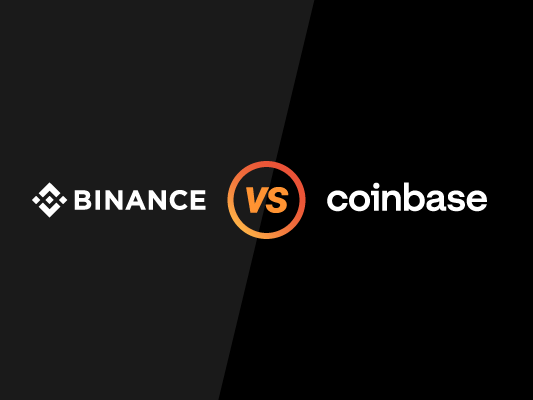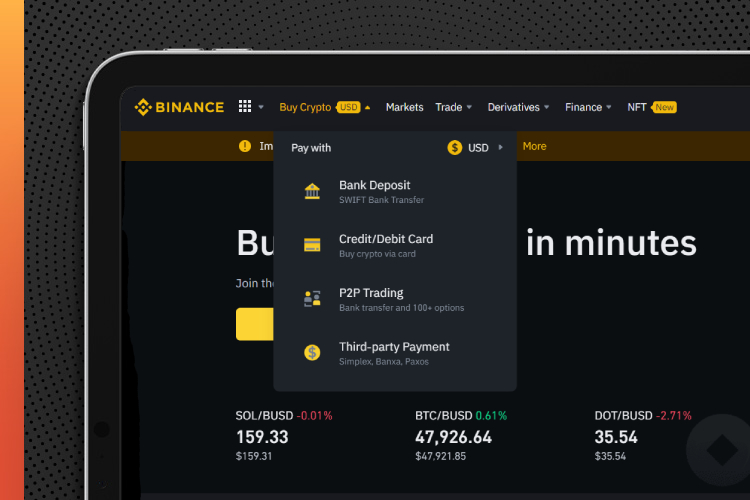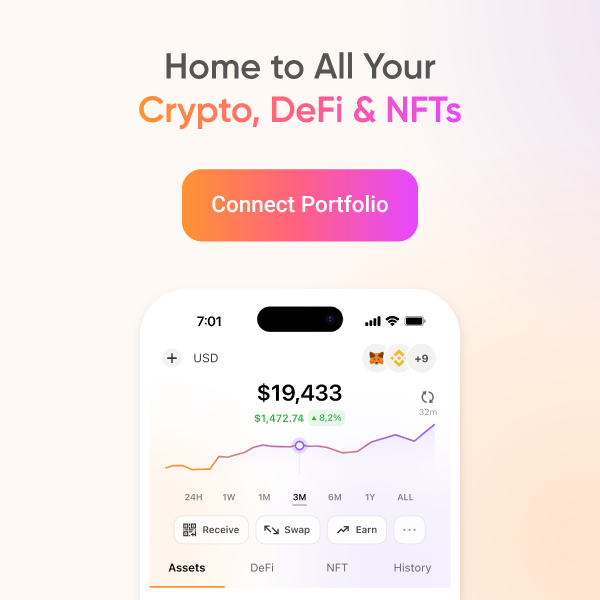
Binance vs Coinbase [Exchange Comparison Review For 2023]
In this article, CoinStats delves into the world of two exchanges to know which one is better in the always-heated Binance vs Coinbase competition.
Binance and Coinbase are among the best cryptocurrency exchanges in the world. So, if you can’t decide which platform suits your needs best, keep reading our overview of both cryptocurrency exchanges for ease of use; bank account integration; supported payment methods; supported currencies and trading pairs; brokerage products and features; platform security; crypto brokerage and trading fees; as well as regulatory information. Binance vs Coinbase
Whether you are a novice or an experienced crypto investor wanting to use deflationary currency as an inflation hedge or go long on blockchain technology for a risk-reward investment in a fast-growing high-tech industry, you can benefit from our cryptocurrency exchange platform comparison guide.
Here’s a brief overview of Binance vs Coinbase:
Binance vs Coinbase: Ease of Use

Both Binance and Coinbase, mobile app and desktop versions, are user-friendly and easy to use for beginner traders and experienced cryptocurrency investors. If you’re just starting to buy and sell digital currencies, either platform will suffice.
Usability for traders of all experience levels is a priority for Coinbase. Coinbase offers an easy-to-navigate interface with an intuitive design. For buying, selling, and trading cryptocurrency on the go, you can use its mobile app on iOS and Android.
Coinbase makes it easy to get started by signing up for a free Coinbase account with your email address and a verification process. Your government-issued photo ID is then used to verify your identity to comply with KYC and AML. Once verified, you can connect a bank account or credit card as a payment method to buy cryptocurrency with fiat currencies. You can also secure your account with two-factor authentication.
Coinbase is considered one of the best crypto exchanges for beginners because of its ease of use and educational content.
Binance makes it simple for new cryptocurrency traders to sign up and start trading, but it also offers advanced charting, multiple trading interfaces, and custom API keys to advanced users.
Signing up for Binance is simple. You have to create a free account using your email address and a password. Once you verify your email address, you can connect it to your bank account or credit card to use them as a payment method. You can also secure your account with two-factor authentication.
Although the Binance platform is user-friendly and offers three levels according to your trading experience, it isn’t nearly as easy to use as Coinbase.
Coinbase’s combination of educational resources, ease of use, and account features make it the best exchange for beginners.
Binance vs Coinbase: Features

Supported Currencies (advantage, Binance for non-U.S.users; Coinbase for U.S. users). Binance and Coinbase both offer access to the top cryptocurrencies on the market, but Binance supports more currencies than Coinbase does.
Coinbase offers 51 trading currencies on its regular platform and 57 on the Coinbase Pro exchange. Coinbase also supports fiat currencies, including USD, GBP, and EUR. In addition to popular favorites like Bitcoin (BTC), Ethereum (ETH), Bitcoin Cash (BCH), Cardano (ADA), Dogecoin (DOGE), Litecoin (LTC), and Uniswap (UNI), you’ll find Wrapped Bitcoin (WBTC), Aave (AAVE), SushiSwap (SUSHI), and Celo (CGLD) on Coinbase. Check out Coinbase’s listing prices for a comprehensive list.
Binance offers advanced traders from non-U.S. countries access to over 500 different cryptocurrencies trading in over 1,000 trading pair liquid markets. However, the Binance.US exchange only supports 52 coins. Binance supports 19 fiat currencies, including USD, EUR, AUD, GBP, HKD, and INR.
Among cryptos offered by Binance (but not by Coinbase) are the Binance coin (BNB), the native utility token of the Binance platform, BND, VeChain (VET), Harmony (ONE), VeThor Token (VTHO), Dogecoin (DOGE), QTUM, and Matic Network (MATIC). Check out Binance’s market listings for its full list of currencies.
Additional features: Designed for advanced traders, Binance offers more advanced trading features than Coinbase. Multiple trading interfaces are available on all versions of the Binance platform, and Binance users worldwide can stake and lend their cryptocurrencies to earn interest. Binance also offers crypto trading pairs, staking rewards, peer-to-peer trading, secure storage, over-the-counter (OTC) trading, the option to use Trust Wallet, advanced charting with hundreds of indicators and overlays, public API keys for integrating other software tools, and more.
The following features are only available on the non-U.S. version of the Binance platform:
- Margin Trading
- Derivatives, including crypto futures, options, and leveraged tokens
- Crypto borrowing
- Non-fungible tokens
Furthermore, U.S. users can’t pay via credit card, whereas Coinbase supports credit card payments, and you can make margin trades on Coinbase Pro.
You currently can’t use Binance.US if you’re a resident of Connecticut, Hawaii, Idaho, Louisiana, New York, Texas, or Vermont.
The Coinbase platform offers the following special features:
- Learn and earn: It allows users to earn free crypto by completing educational modules.
- Newsfeed: A built-in news feed keeps users informed about the latest crypto news.
- PayPal integration: Users can buy crypto using their PayPal accounts.
- Hot Wallet: A secure, standalone digital hot wallet that you can use with Coinbase and other exchanges.
Coinbase Pro offers the following advanced trading tools: trading APIs, charting tools, and order books (including $250,000 FDIC insurance).
Beginner Support (advantage, Coinbase): Coinbase offers free educational resources to Coinbase users. Users can watch the educational videos on the platform and mobile app and will be rewarded with a small amount of free cryptocurrency for watching them.
Binance also offers Binance Academy to educate its users free of charge.
However, Coinbase makes it easy for new investors to buy crypto.
Binance vs Coinbase: Security
Both Binance and Coinbase are considered secure cryptocurrency exchanges and offer robust security settings to protect your digital assets. However, Coinbase has a better overall reputation: it is highly liquid, making it a safe choice for investors in a volatile market. Here are a few of the security options available on each platform:
Coinbase
Coinbase is a U.S.-based exchange and is backed by banks like J.P. Morgan. Coinbase provides users with the Coinbase wallet, its own proprietary cryptocurrency wallet for storing your cryptocurrency. The wallet stores your private keys and is protected with a password and biometric access controls. It also has an encrypted 12-word recovery phrase protecting your assets.
Other security measures that Coinbase offers are:
- Two-factor authentication (2FA) via SMS or the Google Authenticator app.
- Cold storage and crypto vaults: Coinbase is one of the only exchanges that keep your assets in “cold storage” (offline), protecting your assets from online hacks. It also offers a time-locked cryptocurrency vault to prevent fraud.
- FDIC Insurance (up to $250K): Coinbase also offers FDIC insurance of up to $250,000 on deposited USD funds held in custodial bank accounts.
Binance
Binance also provides a wallet to its users, the Binance Chain Wallet. It is the official Binance cryptocurrency wallet, developed in-house for users to access the Binance Smart Chain, Binance Chain, and Ethereum. It is also a secure way to store your private keys and connect to thousands of projects across different blockchains.
Other security measures that Binance offers are:
- Two-factor authentication (2FA) via the Google Authenticator app or SMS, but U.S. users report some problems with the Binance.US and Google authentication process.
- All USD balances are insured up to $250,000 by the FDIC and held in custodial bank accounts.
Binance also offers address whitelisting, device management, and the ability to restrict device access.
Binance vs Coinbase: Fees
There is a significant difference in fees between Binance and Coinbase. Overall, Binance offers significantly low fees for trading cryptocurrencies as well as funding your account.
Coinbase charges users an average flat fee of 0.50% per transaction, plus extra fees based on your payment method, meaning you might pay up to 4% per transaction. If you purchase and sell a cryptocurrency on the same day using a credit card, this can cost up to 9% of the total price.
Coinbase Pro uses tiers, with more or higher dollar transactions coming with lower costs.
Binance offers much lower fees (0.1% fee per transaction) and lower charges for high trading volume (down to 0.02% for the most advanced users and active crypto traders). While it also uses a maker-taker fee structure, both the maker and taker fees are identical. Binance users can lower costs by purchasing Binance (BNB) tokens to pay fees with a 25% discount.
Binance vs Coinbase: Regulatory
In terms of regulation, Coinbase, a U.S.-based exchange set to go public via a direct listing, has an advantage over Binance.
Unlike Coinbase, Binance was first established in China before moving to Japan. Binance isn’t regulated, so it initially banned all U.S. residents from accessing the platform. However, its new Binance.US exchange stays within U.S. regulations.






